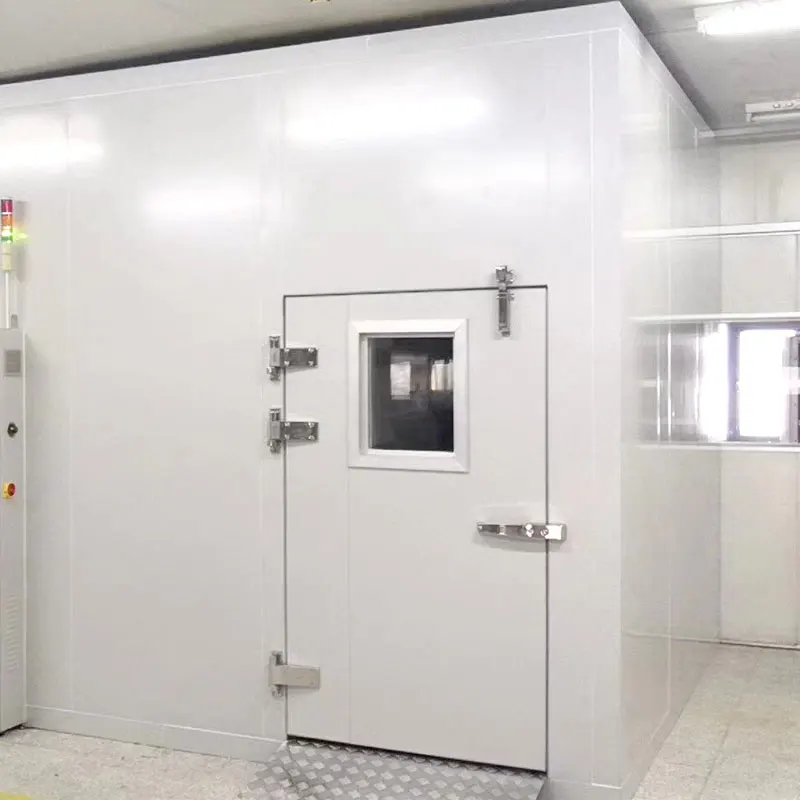Materialauswahl: Kernfaktoren, die beeinflussen Kühlraumtür Langlebigkeit
Wie die Materialwahl die Leistung einer Kühlraumtür beeinflusst
Die Wahl des Materials bestimmt direkt, inwieweit eine Kühlraumtür extremen Temperaturen (-30 °C bis +10 °C), häufigen Reinigungen und mechanischen Belastungen standhält. Stahltüren mit Polyurethan-Dämmung bieten eine um 35 % bessere Wärmerückhaltung als Standardmodelle, während falsche Materialentscheidungen für 42 % der vorzeitigen Türausfälle in Kühllageranlagen verantwortlich sind (ASHRAE 2023).
Glasfaserverstärkter Kunststoff vs. Edelstahl: Festigkeit und Langlebigkeit bei extremen Temperaturen
| Eigentum | Glasfaserverbundstoff | Edelstahl |
|---|---|---|
| Zugfestigkeit | 1.000 MPa | 520–750 MPa |
| Wärmeleitfähigkeit | 0,04 W/mK | 16 W/mK |
| Korrosionsbeständig | Exzellent | Vorgesetzter |
Türen aus glasfaserverstärktem Kunststoff (FRP) bieten eine Feuchtigkeitsbeständigkeit von 98 % und eignen sich daher ideal für die Verarbeitung von Meeresfrüchten. Varianten aus Edelstahl halten um 50 % höhere Schlagbelastungen aus und werden deshalb in stark frequentierten Fleischverpackungsanlagen bevorzugt. Aktuelle Studien zur Materialhaltbarkeit zeigen, dass FRP-Türen ihre strukturelle Integrität über mehr als 100.000 Frost-Tau-Wechsel hinweg beibehalten.
Korrosionsbeständigkeit bei Kaltlagerungstürmaterialien
Edelstahl 316L widersteht Korrosion durch Salzsprühnebel dreimal länger als der Standardtyp 304, was in maritimen Kühllageranlagen ein entscheidender Vorteil ist. FRP-Oberflächen erreichen Rauheitswerte unter 0,5 Ra, hemmen so das mikrobielle Wachstum und senken die Reinigungskosten um 18 % im Vergleich zu strukturierten Metalloberflächen (Food Safety Magazine 2023).
Weißes Metall und FRP: Vergleich von Haltbarkeit und Wartungsanforderungen
Weißmetall-Legierungstüren erfordern 60 % weniger Wartung als verzinkter Stahl, bieten jedoch eine vergleichbare Festigkeit. FRP-Modelle eliminieren die Notwendigkeit von Schmierung durch selbstschmierende Scharnier-Systeme, wie umfassende Branchenbewertungen gezeigt haben. Beide Materialien können bei sachgemäßer Installation in pharmazeutischen Kühllagerungen eine Lebensdauer von über 20 Jahren erreichen.
Wärmedämmung und Energieeffizienz in Türen des Kühlraums

Wesentliche Dämmeigenschaften für optimale thermische Leistung
Kühllagertüren müssen eine hohe Wärmedurchgangswiderstand (R-Wert) aufweisen, um Wärmeübertragung zu minimieren. Polyurethan-Schaum (R-6,5 pro Zoll) und extrudiertes Polystyrol (R-5,0 pro Zoll) werden häufig verwendet, da sie unter extremen Bedingungen eine gleichbleibende Leistung bieten und den FDA- und HACCP-Standards entsprechen. Wesentliche Dämmeigenschaften umfassen:
- Durchgehende Wärmebarrieren verhinderung von Kondensation
- Kantenversiegelte Kerne beständigkeit gegen Feuchtigkeitspenetration
- Nichtleitende Rahmen minimierung von Wärmebrücken
Türen mit R-Werten unter 4,0 führen laut Frigosys (2024) in Gefriermittellageranwendungen zu 17 % höheren Energiekosten.
Wie eine ordnungsgemäße Dichtung Energieverluste verhindert und die Effizienz erhält
Dichtungen aus Ethylen-Propylen-Dien-Terpolymer (EPDM) am Türumfang reduzieren den Luftaustritt um 95 % im Vergleich zu einfachen Gummidichtungen. Automatische Türschließer und magnetische Verriegelungen gewährleisten eine dichte Schließung auch bei über 50 täglichen Öffnungen – entscheidend in pharmazeutischen Lagern, wo die Temperaturstabilität innerhalb von ±1 °C liegen muss.
Senkung der Betriebskosten durch hochwertige Türdämmung
Die Aufrüstung auf Premium-Dämmung (R-8 bis R-12) erbringt typischerweise nach 18 bis 24 Monaten eine Amortisation durch reduzierten Energieverbrauch:
| Faktor | Standardtür | Hochleistungstür |
|---|---|---|
| Jährlicher Energieverbrauch | 8.200 kWh | 5.700 kWh |
| Kompressor-Laufzeit | 78% | 62% |
| Abtauvorgänge | 12/Tag | 7/Tag |
Einrichtungen, die Vakuumdämmplatten verwenden, berichten von jährlichen Kältekostenreduktionen von bis zu 34 %, während sie Umgebungen mit -25 °C aufrechterhalten (Tunel Group 2023).
Strukturelle Integrität und Schlagfestigkeit in industriellen Umgebungen
Konstruktionsmerkmale, die die strukturelle Festigkeit von erhöhen Türen des Kühlraums
Die Haltbarkeit von Kühllager-Türen beginnt mit verstärkten Rahmen und Verbundplatten, die erheblichen Belastungen standhalten können. Stahlhalterungen, galvanisch verzinkt zur Korrosionsbeständigkeit, erhöhen laut einer im letzten Jahr im Industrial Engineering Journal veröffentlichten Studie die Festigkeit der Tür um etwa 40 %. Diese Halterungen arbeiten zusammen mit dreidimensional geschweißten Rahmen, die lästige Schwachstellen beseitigen, an denen Schäden normalerweise zuerst auftreten. Für die äußere Schicht kombinieren Hersteller häufig glasfaserverstärktes Polymer mit Polyurethan-Kernen im Inneren. Diese Hybridkonstruktion widersteht Aufprallen mit fast 28.000 Pfund pro Quadratzoll, ohne dass Kälte entweicht. Selbst nach Jahren andauernden Zuschlagens durch Gabelstapler, die Tag für Tag durch Lagergänge rasen, bleiben diese Türen dank Edelstahl-Scharnieren und mehrfachen Verriegelungssystemen präzise ausgerichtet und fest verschlossen.
Hochgeschwindigkeits-Rolltore für Tiefkühlräume: Die Balance zwischen Haltbarkeit und Betriebsgeschwindigkeit
Heutige Hochgeschwindigkeits-Rolltore können problemlos über 120 Öffnungs- und Schließvorgänge pro Tag bewältigen, da sie robuste industrielle Aluminiumlamellen mit speziellen T-Nuten-Verbindungen verwenden. Diese konstruktiven Verbesserungen reduzieren den Verschleiß an den Kontaktstellen um etwa zwei Drittel im Vergleich zu älteren Modellen, wie letztes Jahr in der Cold Chain Technology Review berichtet wurde. Das Führungssystem ist mit Wärmebrückenunterbrechungen ausgeführt, sodass selbst bei Temperaturen unter null Grad Celsius kein Eis entsteht, wodurch lästige Blockierungen während des Winterbetriebs vermieden werden. Steuerungen, die den Sicherheitsnormen entsprechen, passen ihre Geschwindigkeit automatisch an das Maß des Fußgängerverkehrs an, halten den Betrieb auf etwa vier Sekunden pro Zyklus und verhindern gleichzeitig Unfälle. Für Bereiche, in denen Sichtbarkeit wichtig ist, sind diese Tore mit klaren Polyesterfenstern erhältlich, die kratzfest beschichtet sind, was sie sowohl sicher für die Mitarbeiter als auch widerstandsfähig genug für den täglichen Lagerbetrieb macht.
Hygiene-, Sicherheits- und Schutzanforderungen für Lebensmittel- und Pharmaanwendungen
Hygienische Konstruktion und leicht zu reinigende Oberflächen für Kühltüranlagen
Kühlbereiche in der Lebensmittelverarbeitung und pharmazeutischen Laboren benötigen Türen mit glatten, nicht saugfähigen Oberflächen, da sich Bakterien gerne in Rissen und Spalten verstecken. Materialien wie elektropoliertes Edelstahl und glasfaserverstärkter Kunststoff (FRP) reduzieren Keime erheblich – Studien aus dem Jahr 2024 zeigen, dass sie das Kontaminationsrisiko im Vergleich zu herkömmlichen strukturierten Metallen um etwa 87 % senken können. Auch die Türkonstruktionen selbst sind wichtig. Abgeschrägte Flächen und abgerundete Ecken verhindern Wasseransammlungen, an denen Mikroben wachsen könnten. Und diese NSF-zertifizierten Dichtungen? Sie widerstehen den harten chemischen Reinigungen während der regelmäßigen Wartungszyklen. All diese kleinen Details machen einen großen Unterschied, wenn Unternehmen gesetzliche Hygienestandards einhalten und kostspielige Stillstände aufgrund von Sanitärproblemen vermeiden möchten.
Sicherheitsmechanismen zum Schutz von Personal und Produkten
Heutige Kühltüren sind mit mehreren wichtigen Sicherheits- und Effizienzmerkmalen ausgestattet. Die meisten Modelle verfügen über blockierungsfreie Sicherheitsstangen, die verhindern, dass Mitarbeiter eingeschlossen werden, sowie über Lichter, die automatisch angehen, wenn sich jemand nähert. Zudem erfüllen sie alle Anforderungen gemäß der OSHA-Vorschrift 29 CFR 1910 bezüglich Notausgänge. Für Anlagen, die bei extrem niedrigen Temperaturen von etwa minus dreißig Grad Celsius betrieben werden, werden spezielle beheizte Türschwellen an den Eingängen installiert. Diese verhindern Eisbildung, die laut jüngsten Daten für etwa ein Viertel der Ausrutschunfälle in Kühlbereichen verantwortlich ist, wie in der Sicherheitsstudie der Branche des vergangenen Jahres berichtet wurde. Eine weitere intelligente Ergänzung sind die bruchsicheren Polycarbonatfenster, die in viele moderne Türen eingebaut sind. Sie ermöglichen es den Mitarbeitern, den Innenraum zu überprüfen, ohne die Tür tatsächlich öffnen zu müssen, was zur Aufrechterhaltung konstanter Temperaturen in der gesamten Anlage beiträgt und langfristig unnötigen Energieverbrauch reduziert.
Sicherheitsmerkmale zur Verhinderung unbefugten Zugriffs und Gewährleistung der Einhaltung von Vorschriften
Für pharmazeutische Kühllager bedeutet die Einhaltung von Vorschriften, Türen mit biometrischen Schlössern zu installieren und detaillierte, verschlüsselte Aufzeichnungen gemäß den Anforderungen der 21 CFR Part 11-Standards zu führen. Sicherheit ist heutzutage nicht nur digital – manipulationssichere Scharniere in Kombination mit Bewegungsmeldern tragen erheblich zum Schutz wertvoller Bestände bei. Die FDA betont kontinuierlich die Bedeutung sicherer Zugangsprotokolle im Rahmen der FSMA-Anforderungen, insbesondere beim Lagern von Impfstoffen. Selbst kleine Temperaturschwankungen sind hier entscheidend. Laut einer Studie des Ponemon Institute aus dem Jahr 2023 könnte bereits eine Abweichung von lediglich 2 Grad Celsius biologische Produkte im Wert von rund 740.000 US-Dollar unbrauchbar machen. Solche Verluste verdeutlichen, warum angemessene Sicherheitsmaßnahmen in allen Bereichen des Kühlkettenmanagements so wichtig sind.
Wartungsmaßnahmen zur Maximierung der Lebensdauer von Kälteraumtüren
Einfache Wartung und Zugänglichkeit beim Design von Gefrierschranktüren
Ein effektives Kühltürdesign priorisiert die Zugänglichkeit für routinemäßige Wartungsarbeiten. Komponenten wie Scharniere, Dichtungen und Rollen sollten erreichbar sein, ohne die Tür vollständig zu demontieren. Funktionen wie ausziehbare Dichtungssysteme oder werkzeugfreier Zugriff auf Rollen minimieren Ausfallzeiten. Branchendaten zeigen, dass 63 % der vorzeitigen Ausfälle auf eine schlechte Komponentenzugänglichkeit zurückzuführen sind, die notwendige Reparaturen verzögert.
Präventive Wartungsstrategien und häufige Fehlerquellen
Geplante Inspektionen alle 90–120 Tage können 85 % aller potenziellen Störungen frühzeitig erkennen. Wesentliche Prüfbereiche umfassen:
- Versiegelungsintegrität : Rissige oder komprimierte Dichtungen verursachen 40 % aller Energieverluste
- Konstruktionelle Ausrichtung : Fehlausgerichtete Laufbahnen erhöhen die Motorbelastung um bis zu 300 %
- Korrosionsanfälligkeiten : Insbesondere an Scharniergelenken und Verriegelungen
Einrichtungen, die prädiktive Wartungsstrategien einsetzen, verzeichnen eine Verringerung von Notreparaturen um 35 % (Thermal Systems Report, 2023).
Bewährte Methoden für langfristige Leistung und Zuverlässigkeit
Regelmäßige Schmierung ist unerlässlich – die Anwendung hochwertiger, silikonbasierter Schmierstoffe alle 6–8 Wochen verlängert die Lebensdauer der Komponenten um 2–3 Jahre. Weitere empfohlene Vorgehensweisen sind:
- Vierteljährliche Drehmomentkontrolle der Befestigungsschrauben
- Zweimonatliche Dichtheitsprüfung der Dichtungen
- Jährliche professionelle Überprüfung der Ausrichtung
Organisationen, die Wartungsmaßnahmen dokumentieren, erzielen im Durchschnitt eine um 22 % längere Nutzungsdauer der Türen im Vergleich zu solchen ohne formelle Aufzeichnungen.
FAQ-Bereich
Welche Materialien eignen sich am besten für Kühlraumtüren?
Materialien wie stahlverkleidete Polyurethan-Isolierung, glasfaserverstärkter Kunststoff (FRP) und Edelstahl werden bei Kühlraumtüren bevorzugt, da sie langlebig sind, eine gute Wärmedämmung bieten und widerstandsfähig gegenüber Umwelteinflüssen sind.
Wie gewährleisten Kühlraumtüren die thermische Effizienz?
Kühlraumtüren gewährleisten thermische Effizienz durch Isolationsmaterialien mit hohem R-Wert, wie z. B. Polyurethanschaum, sowie konstruktive Merkmale wie durchgängige Wärmebarrieren und randversiegelte Kerne.
Welche Wartung ist für Kühlraumtüren erforderlich?
Die regelmäßige Wartung umfasst planmäßige Inspektionen, Schmierung, Dichtheitsprüfungen der Dichtungen, strukturelle Ausrichtung und Drehmomentkontrollen an Befestigungsschrauben, um vorzeitige Ausfälle zu vermeiden und die Funktionalität aufrechtzuerhalten.
Wie senken Hochleistungstüren die Betriebskosten?
Hochleistungstüren senken die Betriebskosten, indem sie den Energieverbrauch reduzieren, die Laufzeit des Kompressors verringern und die Häufigkeit von Abtauzyklen mindern, was letztendlich eine Kapitalrendite innerhalb von 18 bis 24 Monaten ermöglicht.
Inhaltsverzeichnis
- Materialauswahl: Kernfaktoren, die beeinflussen Kühlraumtür Langlebigkeit
- Wärmedämmung und Energieeffizienz in Türen des Kühlraums
- Strukturelle Integrität und Schlagfestigkeit in industriellen Umgebungen
- Hygiene-, Sicherheits- und Schutzanforderungen für Lebensmittel- und Pharmaanwendungen
- Wartungsmaßnahmen zur Maximierung der Lebensdauer von Kälteraumtüren
- FAQ-Bereich

